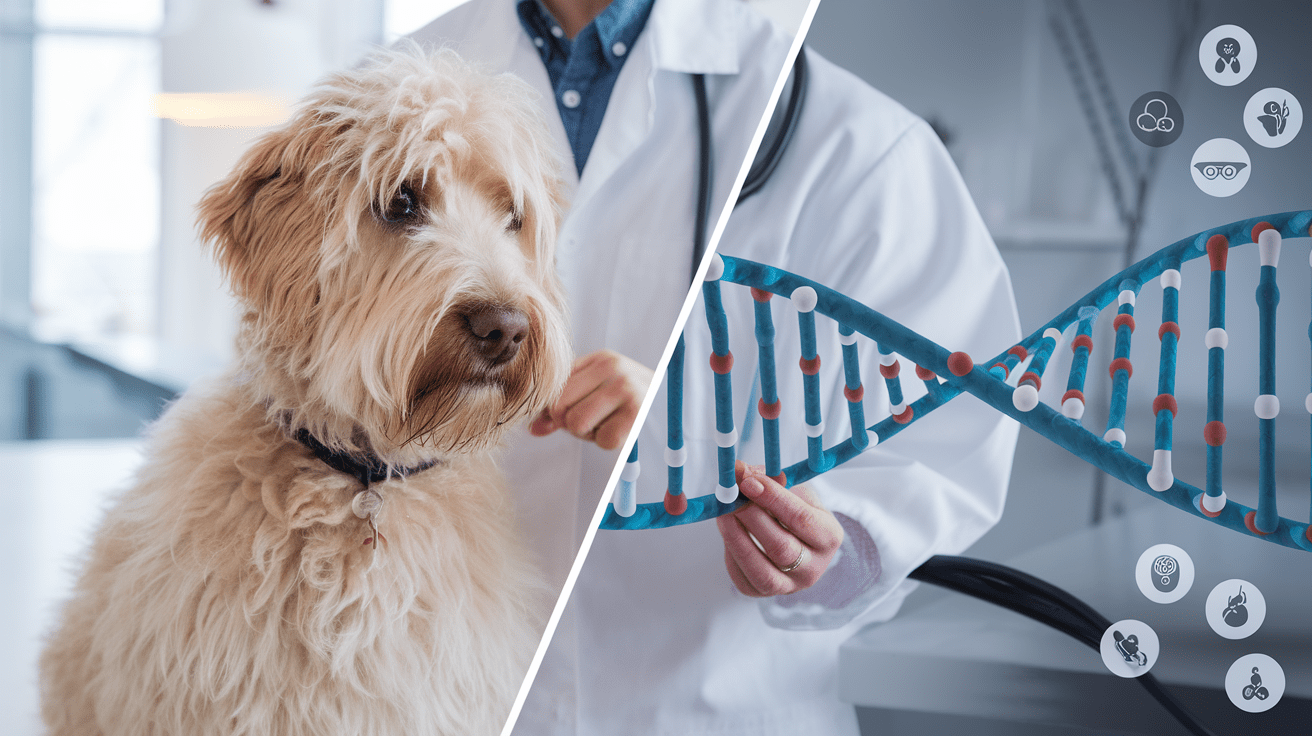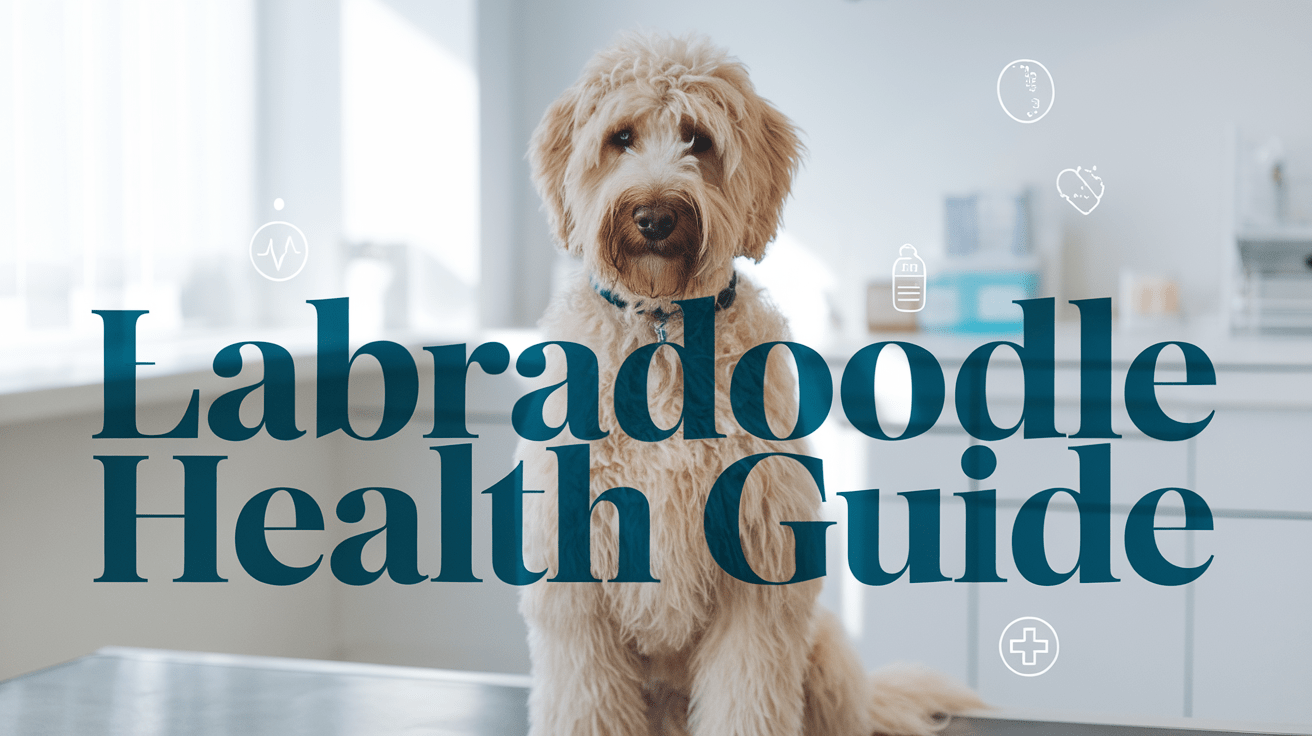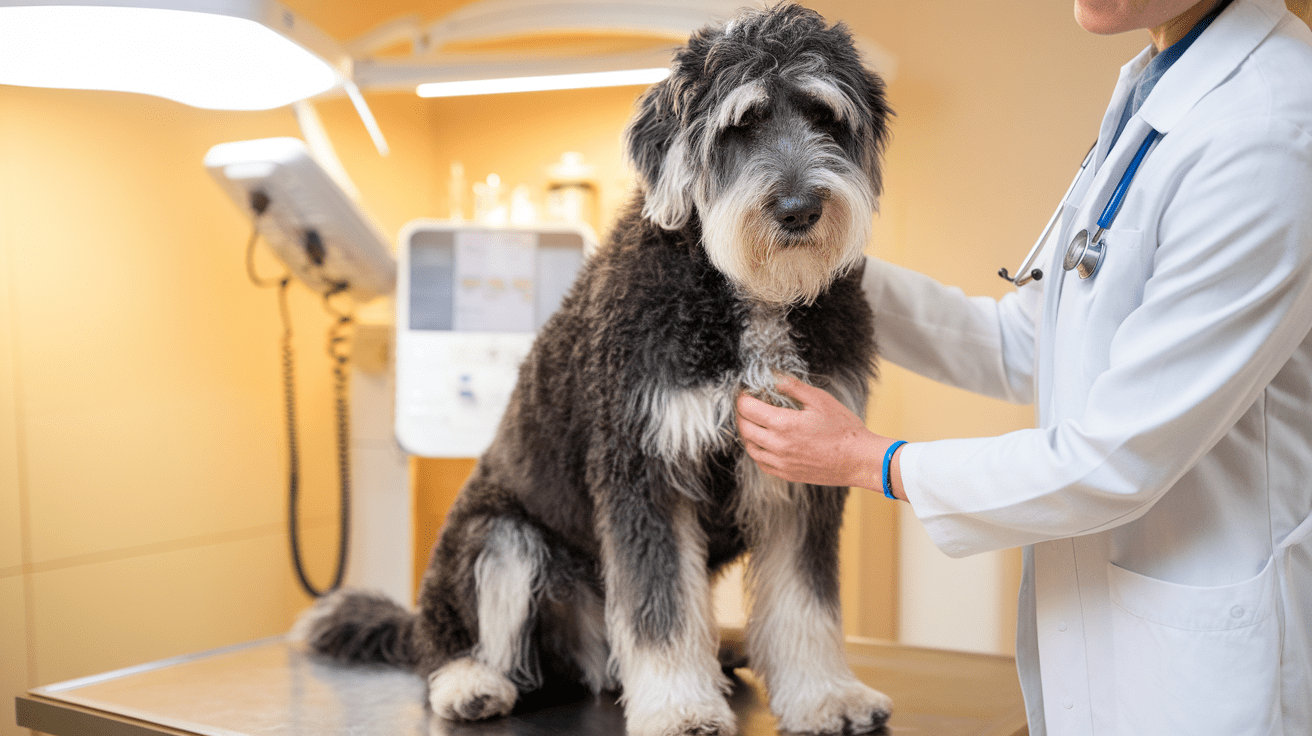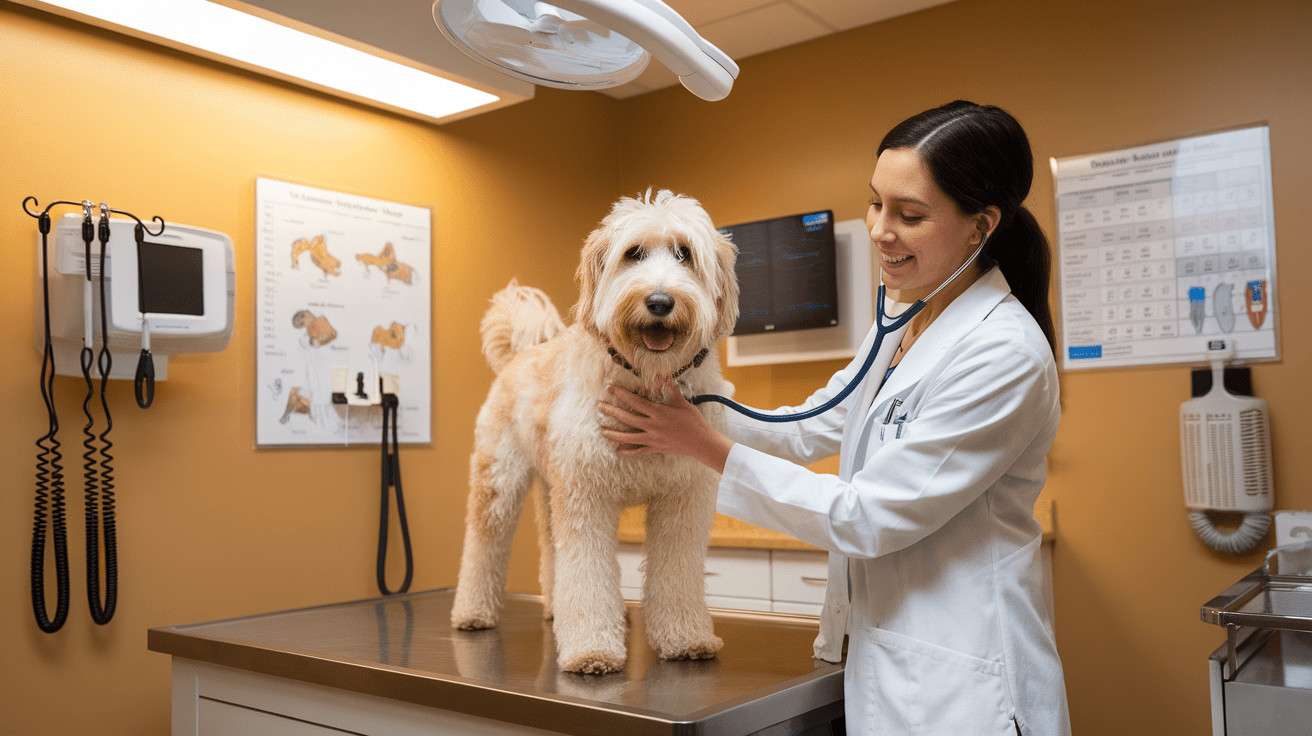Labradoodle Health Issues Key Takeaways
- ✓ Genetic Testing: Early genetic screening is crucial for identifying potential health risks and implementing preventive measures.
- ✓ Common Health Issues: Hip dysplasia, eye conditions, and ear infections are among the most frequent health concerns in Labradoodles.
- ✓ Preventive Care: Regular veterinary check-ups, proper grooming, and maintaining ear hygiene are essential for preventing health problems.
- ✓ Skin Health: Regular grooming and monitoring for allergies or hot spots are crucial for maintaining coat and skin health.
- ✓ Breed-Specific Care: Understanding inherited traits from both Labrador and Poodle parents helps in providing targeted healthcare.
As a Labradoodle owner or prospective parent, understanding your furry friend’s potential health issues is crucial for their long-term wellbeing. According to the American Kennel Club, nearly 40% of Labradoodles may experience at least one hereditary health condition during their lifetime.
Throughout my 15 years of treating these lovable hybrids, I’ve noticed that while Labradoodles are generally healthy dogs, they can inherit health concerns from both Labrador Retrievers and Poodles. The good news? Most common health issues can be prevented or effectively managed with proper knowledge and care.
Think of this guide as your comprehensive roadmap to understanding, preventing, and managing potential health challenges your Labradoodle might face. From genetic predispositions to age-related concerns, we’ll explore everything you need to know to keep your furry companion healthy and happy for years to come.
Understanding Labradoodle Genetics and Inherited Health Risks

As a veterinarian who’s worked extensively with designer breeds, I can tell you that Labradoodle genetics are fascinating yet complex. These dogs inherit traits from both parent breeds, which can be both a blessing and a challenge. According to UC Davis Veterinary Medicine, contrary to popular belief, mixed breeds aren’t automatically healthier than purebreds – it all depends on the specific genetic makeup.
Genetic Testing and Screening Recommendations
I always recommend comprehensive genetic testing for Labradoodles, particularly for:
• Progressive Retinal Atrophy (PRA)
• von Willebrand’s Disease
• Exercise-Induced Collapse (EIC)
• Hip and elbow certification
Think of genetic testing as reading your dog’s autobiography before it’s written – it helps you prepare for potential chapters ahead. Just last month, I worked with a Labradoodle puppy whose genetic screening helped us prevent serious vision problems through early intervention.
Impact of First vs Multi-Generation Breeding
The generation of your Labradoodle significantly impacts their health profile. F1 Labradoodles (first generation) often show more predictable health patterns, while multi-generational breeds can have more variable outcomes. It’s like shuffling a deck of cards – each new generation creates a unique combination of genetic traits.
I’ve observed that F1B Labradoodles (backcross to Poodle) tend to inherit more Poodle-specific health concerns, while straight F1s might show a more balanced health profile between both parent breeds.
Role of Parent Breeds in Health Predispositions
Understanding your Labradoodle’s heritage is crucial. From Labradors, they might inherit tendencies for:
• Hip dysplasia
• Elbow problems
• Exercise-induced collapse
From Poodles, common inherited concerns include:
• Addison’s disease
• Sebaceous adenitis
• Eye problems
Remember, knowing these predispositions doesn’t mean your Labradoodle will definitely develop these conditions – it simply helps you stay vigilant and proactive in their healthcare. Just as we inherit certain traits from our parents but aren’t destined to experience all their health issues, the same applies to our four-legged friends.
Most Common Health Problems in Labradoodles

In my veterinary practice, I’ve found that while Labradoodles are generally robust dogs, they do face several common health challenges. According to a study by VetInfo, approximately 45% of Labradoodles will experience at least one of these common health issues during their lifetime.
Hip and Elbow Dysplasia
Hip and elbow dysplasia are among the most frequent orthopedic issues I encounter in Labradoodles. Think of these joints like a ball and socket that should fit perfectly together – when they don’t, it causes pain and mobility issues. I recently treated a 4-year-old Labradoodle named Max who showed early signs of hip dysplasia. Through early detection and proper management, he’s now living an active, comfortable life.
Signs to watch for include:
• Difficulty getting up from rest
• Reluctance to climb stairs
• Bunny-hopping gait
• Decreased activity level
Eye Conditions and Vision Problems
Progressive Retinal Atrophy (PRA) and cataracts are the most common eye conditions I diagnose in Labradoodles. These conditions can be compared to a camera slowly losing its ability to capture clear images. Regular eye examinations are crucial, especially since many eye conditions are hereditary.
Common eye issues include:
• Progressive Retinal Atrophy
• Cataracts
• Glaucoma
• Cherry eye
Ear Infections and Maintenance
Those adorable floppy ears that make Labradoodles so charming also make them prone to ear infections. Think of their ear canals like a greenhouse – warm and potentially moist, creating the perfect environment for bacterial and yeast growth. Regular cleaning and monitoring are essential.
In my practice, I’ve developed a simple ear care routine that has helped countless Labradoodle owners prevent chronic ear problems:
• Weekly ear checks
• Regular cleaning with veterinary-approved solutions
• Keeping ears dry after swimming or bathing
• Immediate attention to any signs of discomfort or unusual odor
Remember, these health issues don’t define your Labradoodle’s life. With proper awareness and preventive care, many of these conditions can be managed effectively or prevented altogether. The key is staying proactive and maintaining regular veterinary check-ups.
Skin and Coat-Related Health Issues

Having treated hundreds of Labradoodles over the years, I’ve noticed that skin and coat issues are among the most frequent concerns that bring these dogs to my clinic. According to a Veterinary Dermatology Journal, approximately 65% of Labradoodles experience some form of skin or coat-related issue during their lifetime.
Allergies and Skin Sensitivities
Labradoodles can be particularly sensitive to environmental and food allergens. Think of their skin as a protective suit – when it’s compromised by allergies, it can’t properly defend against irritants. Just last week, I treated a Labradoodle named Luna who developed severe allergic reactions to certain grass types. Through proper identification and management, we were able to significantly improve her quality of life.
Common allergy symptoms include:
• Excessive scratching or licking
• Red, inflamed skin
• Recurring ear infections
• Hair loss in patches
Matting and Grooming Challenges
Regular grooming isn’t just about aesthetics – it’s crucial for your Labradoodle’s health. Their unique coat type, inherited from both parent breeds, can be compared to a thick wool sweater. Without proper maintenance, it can become a breeding ground for skin problems.
Essential grooming practices include:
• Brushing 3-4 times per week
• Professional grooming every 6-8 weeks
• Regular bathing with appropriate dog shampoos
• Careful attention to areas prone to matting
Hot Spots and Skin Infections
Hot spots are areas of acute moist dermatitis that can develop rapidly, especially in Labradoodles with thick coats. Picture them as small areas of inflammation that, if left untreated, can spread like wildfire. The dense, often curly coat of Labradoodles can trap moisture against the skin, creating an ideal environment for bacterial growth.
Prevention and treatment strategies include:
• Keeping the coat clean and dry
• Immediate attention to any signs of irritation
• Using medicated shampoos when recommended
• Maintaining proper flea and tick prevention
I always remind my clients that skin and coat health is often a reflection of overall health. Many skin issues can be prevented or minimized through proper nutrition, regular grooming, and prompt attention to any changes in your dog’s skin or coat condition. Remember, what might seem like a minor irritation today could develop into a more serious problem if left unaddressed.
Age-Related Health Concerns

As Labradoodles age, they face unique health challenges that require special attention. According to a Cornell University Veterinary Study, nearly 80% of Labradoodles over the age of 8 develop at least one age-related health condition. Having observed hundreds of Labradoodles through their golden years, I’ve learned that early recognition of these issues is key to maintaining their quality of life.
Joint Problems and Arthritis
Just like humans, Labradoodles often experience joint stiffness and arthritis as they age. Think of joints as the hinges on a door – over time, they can become rusty and less smooth in their movement. I recently worked with a 10-year-old Labradoodle named Cooper, who showed remarkable improvement with a combination of appropriate exercise, joint supplements, and weight management.
Common signs of joint issues include:
• Morning stiffness
• Difficulty rising after rest
• Reluctance to jump or climb stairs
• Changed gait or limping
Dental Issues and Oral Health
Dental disease is one of the most overlooked yet serious health concerns in aging Labradoodles. Your dog’s mouth is like a gateway to their overall health – problems here can affect their entire body. Regular dental care is crucial for preventing more serious health issues.
Essential dental care includes:
• Annual professional cleanings
• Regular tooth brushing at home
• Dental chews and appropriate toys
• Monitoring for signs of dental disease
Cancer and Tumor Risks
While it’s a difficult topic to discuss, cancer awareness is crucial for Labradoodle owners. These dogs can be susceptible to various types of tumors, particularly as they age. Early detection often makes a significant difference in treatment outcomes.
Key monitoring points include:
• Regular checks for unusual lumps or bumps
• Changes in appetite or energy levels
• Unexplained weight loss
• Any unusual bleeding or swelling
Through my years of practice, I’ve found that proactive care is the best approach to managing age-related health concerns. Remember, aging is not a disease, but it does require adjustments in care and attention. Regular check-ups become even more important as your Labradoodle enters their senior years, typically around age 7-8. With proper care and attention, many Labradoodles can enjoy healthy, comfortable lives well into their senior years.
Preventive Care and Management

Preventive care is the cornerstone of maintaining your Labradoodle’s health throughout their life. According to a study by the American Veterinary Medical Association, dogs receiving regular preventive care live an average of 2.5 years longer than those who don’t. During my years at the clinic, I’ve seen how consistent preventive care can make a remarkable difference in a Labradoodle’s quality of life.
Recommended Vaccination Schedule
Think of vaccinations as your Labradoodle’s shield against serious diseases. Just like installing security systems in your home, vaccines provide essential protection. I always develop customized vaccination schedules based on each dog’s lifestyle and risk factors.
Core vaccinations include:
• Distemper, Parvovirus, Adenovirus (DAP): Every 3 years after initial series
• Rabies: As required by law
• Bordetella: Annually for social dogs
• Leptospirosis: Annually in at-risk areas
Diet and Exercise Requirements
A balanced diet and proper exercise are fundamental to your Labradoodle’s health. I often compare it to maintaining a car – the right fuel and regular movement keep everything running smoothly. Recently, I worked with a Labradoodle named Bailey who transformed from being overweight to achieving optimal health through a tailored diet and exercise plan.
Key dietary and exercise guidelines:
• High-quality protein-rich food appropriate for age and activity level
• 60-90 minutes of daily exercise
• Mental stimulation through interactive play
• Regular weight monitoring
Regular Health Screening Timeline
Routine health screenings are like regular check-ups for your car – they help catch potential issues before they become serious problems. I recommend a comprehensive screening schedule that adapts as your Labradoodle ages.
Recommended screening schedule:
• Puppies: Monthly checks until 6 months
• Adults (1-7 years): Annual comprehensive exams
• Seniors (8+ years): Bi-annual check-ups with blood work
• Dental evaluations: Every 6-12 months
Remember, preventive care is always more effective – and usually less expensive – than treating conditions after they develop. By following these guidelines and maintaining regular communication with your veterinarian, you can help ensure your Labradoodle lives a long, healthy, and happy life. Every Labradoodle is unique, so don’t hesitate to discuss adjustments to these recommendations based on your dog’s specific needs.
Frequently Asked Questions About Labradoodle Health Issues
Conclusion
As both a veterinarian and Labradoodle enthusiast, I can confidently say that these wonderful dogs can lead long, healthy lives with proper care and attention. While they may face certain health challenges, most can be effectively managed through proactive care and regular veterinary check-ups. Remember that every Labradoodle is unique, and what works for one may not work for another.
The key to maintaining your Labradoodle’s health lies in preventive care, regular screening, and staying informed about potential health issues. By understanding your dog’s genetic background and maintaining open communication with your veterinarian, you can provide the best possible care for your furry friend. With proper attention to their physical and emotional needs, your Labradoodle can remain a happy, healthy, and vibrant member of your family for many years to come.
While understanding health issues is crucial, proper training is equally important for raising a well-balanced Labradoodle. Our comprehensive Labradoodle Training Guide provides detailed instructions for mastering 15 essential skills, from basic obedience to advanced commands. A well-trained Labradoodle not only exhibits better behavior but also tends to experience less stress and anxiety, contributing to their overall health and happiness. This practical guide offers proven methods and expert tips to help you establish a strong foundation for your furry friend’s development.



